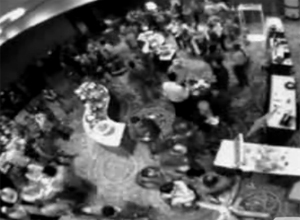Tracking Pollution and Social Movement: Love Fest for Calit2 Technologies at 'Make Fest 2007'
By Doug Ramsey, dramsey@ucsd.edu
San Diego, CA, April 6, 2007 -- Roughly 1,000 people showed up for this year's Emerging Technology Conference (ETech), and Calit2 at UC San Diego was well represented during the conference's show-and-tell session on March 28 at the Grand Hyatt on the San Diego waterfront.
|
Organized by the publishers of Make Magazine, the "Make Fest" session showcased two Calit2 researchers who got the chance to give demos of their work at the intersection of art, technology and urban culture.
For Calit2 postdoctoral researcher Shannon Spanhake, it meant putting her Calit2-funded mobile air pollution monitor through its paces - while giving press interviews between demonstrations. "A reporter from the BBC did an audio interview, CNET News dropped by, and a reporter from Reuters asked lots of questions," recalls Spanhake, who did her undergraduate degree in electrical engineering and received an MFA in Visual Arts from UCSD before joining Calit2. "It was a great night, but I didn't get to see many of the other demos as my table was quite active throughout the night."
Attendees also kept Derek Lomas busy. Lomas is the co-director of the Social Movement Lab at Calit2, with Visual Arts professor Natalie Jeremijenko.
|
"I showed a mobile camera tower that can be set up in 10 minutes by two people and reaches a height of 40 feet," he explains, noting that the set-up (excluding the laptop) only cost about $500, including a 170-degree, wide-angle video camera. "By making the design public through Make Fest, I hoped to stimulate others to engage in low-cost aerial videography." Lomas' collaborator, materials science Ph.D. candidate Albert Lin, helped build the mobile camera tower in record time.
Low-cost what? Lomas originally built the tower to capture time-lapse footage of pedestrian movement around the UC San Diego campus for a class he is teaching this quarter called "Social Architectures." The class is all about the relationship between architecture and social interactions at UCSD, and 13 teams of two students each must create architectural "interventions" that have an observable impact on the movement of people on campus. The tower will allow each pair of students to document easily the impact of their intervention - through time-lapse videography.
|
"This process lets you study the architecture of space to see how it affects social interaction," Lomas told CNET News. (A clip from the demo is available at the Social Movement Lab website, www.socialmovement.org.)
Although it's not yet small enough to be suitable for widespread deployment, Shannon Spanhake's pollution monitor is already generating a lot of interest. Calit2 engineer Don Kimball and his circuits lab colleagues constructed the prototype for sampling and transmitting the pollution data. As conceived by Spanhake, the device - dubbed "Squirrel" - is more than an exercise in shrinking a battery, sensor-on-a-chip and Bluetooth transmitter into something small enough to clasp to a belt or purse, and creating a software database and program to show current carbon-monoxide readings on the cell-phone display (all of which were on display at Make Fest).
|
Squirrel and the companion software, Acorn, also represent a bold exercise in social responsibility and cross-border engagement. "We want to make air quality data visible, accessible and legible to raise consciousness of environmental monitoring," says Spanhake. For this, she has collaborated with Calit2 researcher Kael Greco, author of a mobile webcam application that uploads images taken by the mobile phone automatically and continuously. These images are tagged and manipulated with the sampled pollution data -- the grittier the image, the more polluted the air is -- then displayed in real time on a web page. "This, along with other visual and audible ways, will help to demystify what 20ppm is in a meaningful way," says Spanhake, adding: "Low-cost technology will also make it available and scalable to the technological, environmental and cultural needs of individuals, communities and cities."
The device is low-cost, mobile, and scalable. It is also intended to be a building block for the creation of a mobile wireless sensor network dependent upon those who breathe the air -- people. "Squirrel is meant to monitor an individual's personal exposure to the air, thus providing a means for agency in the production of air pollution data," says Spanhake. "It will enable supplemental data to the environmental protection agencies that cannot afford to scale their technology to population growth and urban sprawl."
There are only a handful of pollution sensors used by the U.S. Environmental Protection Agency (EPA) to gauge pollution levels in San Diego County, and a few more on the other side of the border in Mexico. According to Spanhake, "the price of wireless and sensor technology is now making it feasible that every person with a cell phone could become a pollution monitor, taking readings 24/7 of their personal exposure and feeding the results wirelessly to a database that would give us a lot more concrete data on which to make informed decisions about how to fight pollution at the level of the individual, the region, and the country."
|
Various iterations of the project will be demonstrated throughout the next few months, as Spanhake and Greco travel down Interstate 5 monitoring air quality both inside and outside of the vehicle. Squirrel and Acorn will also be on display in May at Maker Faire, in the Bay Area, another showcase for projects at the intersection of technology, art and culture.
Final note: Squirrel did give the air in the Grand Hyatt a (relatively) clean bill of health. Carbon monoxide was detected at 11 parts per million, well below the threshold of what the EPA considers real air pollution.
Related Links
O'Reilly's ETech Emerging Technology Conference
CNET News Article
CNET Photo Gallery






